Headline News
Wall Street Begins To See Economic Writing On The Wall

The Teamsters and other like-minded allies have been fighting income inequality for years. Slowly, some elected officials began to add their voices to the chorus raising concerns about working Americans. But still, there are many who seem to be in denial about the issue.
However, it is getting increasingly difficult for even the most ardent naysayers to push back on the nation’s growing pay gulf when Wall Street institutions admit there is a problem. This week, ratings agency Standard & Poor’s – creators of the S&P 500 index – said the growing income gap in the U.S. between the rich and everyone else could have long-lasting negative effects on the U.S. economy. It’s time to welcome Wall Street to reality.
An analysis by S&P notes that the income divide is endangering the nation’s economic health by making it more prone to boom-and-bust cycles and has slowed the recovery from the Great Recession. In response, S&P is cutting its growth estimates for the economy for the next decade.
“We see a narrowing of the current income gap as beneficial to the economy,” it wrote. “In addition to strengthening the quality of economic expansions, bringing levels of income inequality under control would improve U.S. economic resilience in the face of potential risks to growth. From a consumer perspective, benefits would extend across income levels, boosting purchasing power among those in the middle and lower levels of the pay scale — while the richest Americans would enjoy increased spending power in a sustained economic expansion.”
The rating service joins the Congressional Budget Office and the International Monetary Fund (and the Teamsters) in their depiction of a “two Americas” separated by wages. And while S&P suggests that greater education would help solve the problem, the problem is more complicated than that.
The roots of the American middle-class’ economic decline are decades in the making. Spurred by a decline in union membership, fewer manufacturing jobs and an increase in the service economy, it has gotten harder and harder for workers to make ends meet. And those changes have been exacerbated by trade deals like NAFTA that have led to more than a million lost jobs.
Improving the outlook for U.S workers isn’t just about creating millions of minimum wage jobs. It is about creating sustainable, skilled employment that allows Americans to earn a fair wage with benefits that allows them to pay for housing and food on the table and sustain a middle-class lifestyle.
If the this country’s public and private sectors want to ensure this change for the better, they are going to have to pitch in. Investing in American infrastructure using American workers will lead to a healthier U.S. economy. And that will benefit everyone.